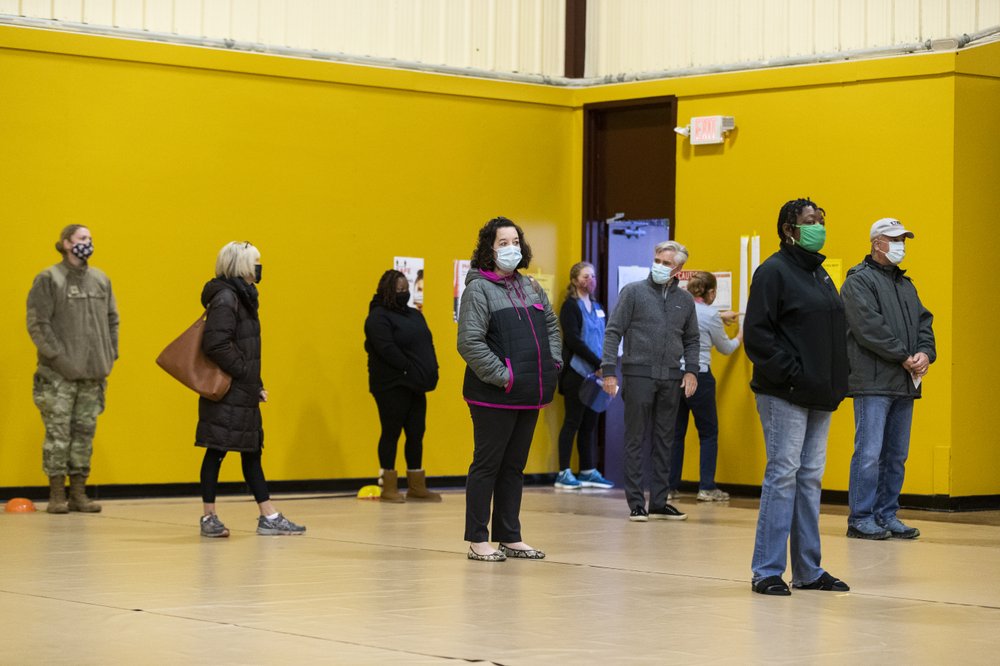
US voters mark end of election like no other at the polls
Voters marked the end of an election like no other at the polls on Tuesday, casting the last of what will likely be a record number of ballots despite a global pandemic that has upended long-established election procedures and triggered hundreds of lawsuits.
Election officials warned that millions of absentee ballots could slow the vote count, perhaps for days, in some key battleground states. President Donald Trump threatened legal action to prevent ballots from being counted after Election Day.
Problems occur every election, and Tuesday was no different. There were long lines early in the day and sporadic reports of polling places opening late, along with equipment issues in counties in Georgia and Ohio. This was all expected given past experience, the decentralized nature of voting in the U.S. and last-minute changes due to the pandemic.
At least 98.8 million people had already voted before Election Day, about 71 percent of the nearly 139 million ballots cast during the 2016 presidential election, according to data collected by The Associated Press. Given that a few states, including Texas, had already exceeded their total 2016 vote count, experts were predicting record turnout this year.
“Come hell or high water,” said Kristen Clarke, executive director of the Lawyers’ Committee for Civil Rights Under Law. “It feels like that has been the attitude voters have needed to make sure their voices are heard this year.”
Those yet to vote headed to polling places despite another spike in COVID-19 cases that has hit much of the country. Among them were voters who may have wanted to vote by mail but waited too long to request a ballot or those who didn’t receive their ballots in time.
Kaal Ferguson, 26, planned to vote by mail but was concerned he hadn’t left enough time to send his ballot back. So he voted in person in Atlanta, despite worries that he could be exposed to COVID-19 by fellow voters.
“Obviously everybody has their right to vote,” he said. “But it’s kind of scary knowing that there’s not a place just for them to vote if they’d had it, so you could easily be exposed.”
Others were likely persuaded by the president’s rhetoric attacking mail voting or simply preferred to vote in person.
“I don’t want to see no mailman. I like to stand here, see my own people, wait in the line and do my civil duty,” said James “Sekou” Jenkins, a 68 year-old retired carpenter and mechanic who waited about 15 minutes before polls opened in West Philadelphia and voted for Democrat Joe Biden about an hour later.
With Democrats dominating the early vote, Republicans were expected to comprise a large share of Tuesday’s voting.
Federal authorities were monitoring voting and any threats to the election across the country at an operations center just outside Washington D.C. Officials there said there were no major problems detected early Tuesday.
“We’re not out of the woods yet,” said Christopher Krebs, the director of the U.S. Cybersecurity and Infrastructure Security Agency. “Today, in some sense, is half-time. There may be other events or activities or efforts to interfere and undermine confidence in the election. So I’d ask all Americans to be patient, to treat all sensational and unverified claims with skepticism, and remember technology sometimes fails and breaks.”
Kathleen Thomas, 61, had to vote by paper ballot because of an issue with voting machines at her polling place in Atlanta. She was pleasantly surprised the process took less than an hour but would rather have used a machine.
“If I had a choice I would prefer to cast a ballot into the machine myself,” she said. “But I guess I have no choice. I can’t go to another precinct. I can’t take that chance. I have to vote.”
In the months leading up to Election Day, election officials had to deal with a pandemic that has infected more than 9 million Americans and killed more than 230,000, forcing them to make systemic changes largely on the fly and mostly without federal money. Meanwhile, Trump repeatedly sought to undermine the election with unsubstantiated claims of widespread voter fraud.
He has particularly targeted the crucial battleground state of Pennsylvania, after the U.S. Supreme Court allowed — at least for now — a three-day extension for receiving and counting absentee ballots. Over the weekend, Trump said that as soon as the polls close there on Tuesday, “We’re going in with our lawyers.”
Misinformation about election procedures, concerns about confrontations at the polls and reports of mail slowdowns also clouded the run-up to Election Day.
The National Association of Secretaries of State worked with the National Association of State Election Directors to help states hammer out plans for protecting against foreign and domestic cyberattacks, countering misinformation and strengthening an election infrastructure tested by massive early voting and pandemic precautions.
Election officials across some 10,000 voting jurisdictions scrambled to purchase personal-protective equipment, find larger polling places, replace veteran poll workers who opted to sit out this year’s election due to health concerns and add temporary workers to deal with the avalanche of mail ballots.
By CHRISTINA A. CASSIDY and ANTHONY IZAGUIRRE
People line up to vote at Martin Luther King Jr. Park in Columbia, S.C., early Tuesday, Nov. 3, 2020. (Joshua Boucher/The State via AP)


 How to resolve AdBlock issue?
How to resolve AdBlock issue? 